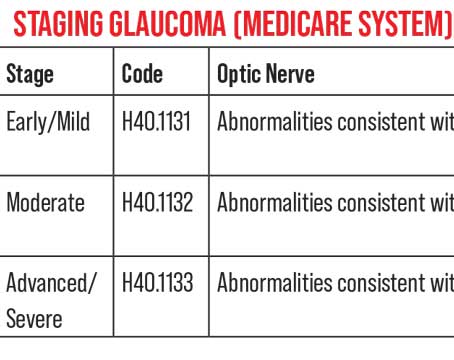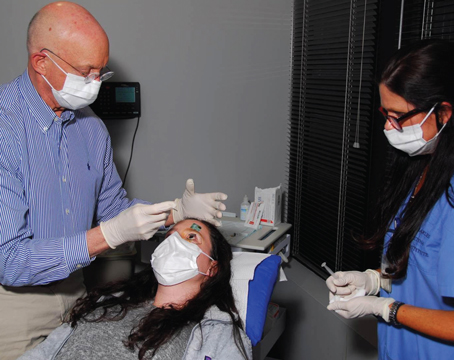When a patient with glaucoma or ocular hypertension is started on medical therapy, the assumption is that this is a long-term commitment. We often see patients on multiple medications and it is not clear that all are contributing to the control of intraocular pressure, though certainly all do contribute to cost, inconvenience and adverse effects. Obviously, only those drugs that are effective in an individual should be used, but it is not always easy to make that determination.
Current Practice
First-line treatment for open-angle glaucoma typically consists of monotherapy with a single agent. Initiation of therapy for the individual patient involves a decision-making process that takes into account drug efficacy, side effects, economic limitations and compliance. It has long been recommended that treatment should be individualized through the implementation of a one-eyed trial of therapy whereby the untreated eye serves as a control to assess drug efficacy.1-4 The most recent revision of Preferred Practice Patterns for Open-Angle Glaucoma from the American Academy of Ophthalmology emphasizes that analysis of the effectiveness of topical therapy (as tailored for the individual patient) requires a separation between the impact of therapeutic intervention and the typical diurnal variations of IOP which exist. In keeping with recent teaching, the PPP states "when starting a new topical agent, it is often useful to begin by treating only one eye and comparing the relative change of the IOP in the two eyes at follow-up visits."4
Is the One-Eyed Trial Valid?
While the application of a one-eyed trial may appear to provide the best estimation of optimal treatment for a particular individual, its validity has not been proven. The measurement of IOP at a specific time point in the treated eye and untreated, control eye may reflect a number of modifying factors which include: (1) a diurnal variation along a specific type of curve,2 (2) various endogenous and exogenous factors such as body position, activity and sleep patterns,5-7 and (3) a direct therapeutic effect or contralateral therapeutic effect.8,9 The interpretation of a one-eyed therapeutic trial as predictive of both therapeutic efficacy in a particular individual and of an identical response in the control eye requires a maintenance of diurnal curve symmetry between paired eyes and a symmetry in drug response between paired eyes. Given the widespread recommendations supporting the use of one-eyed trials, it is necessary to evaluate the assumptions that provide the basis of such trials.
Does IOP Fluctuate Symmetrically?
The validity of the one-eyed trial rests largely on the assumption that the paired eyes of an individual are symmetric and identical in their behavior. A seminal study in 1975 observed that while normal and ocular hypertensive individuals had a difference between fellow eyes of 2 mmHg or less in approximately 93 and 84 percent of all measurements, respectively, those with primary open-angle glaucoma had a difference in pressure of 5 mmHg or more in about 40 percent of all measurements. When examining the variation between fellow eyes over a 24-hour period, however, it was noted that the pressure difference was relatively constant in normal, OHT, and POAG individuals. Based on the results of their hourly measurements, the authors concluded that "a more objective appraisal of drug effects is to treat one eye only, using the fellow eye as a control."10
Arguing against the conclusions of this work is more recent evidence of the lack of symmetry in paired eyes, as well as the tendency towards diurnal curve shifts, particularly in glaucomatous patients. Early studies demonstrated a variation in diurnal curve types between paired eyes in glaucomatous patients.11 One study showed that 6 percent of normal individuals compared to 36 percent of glaucoma patients had different diurnal curve types between paired eyes. At follow-up approximately 12 months later, repeat IOP measurements yielded 56 percent of glaucoma patients demonstrating different diurnal curve types from those that had been initially recorded; about 20 percent showed a shift in curves to an erratic pattern, which highlights the unpredictability of IOP in glaucoma patients. The study concluded that "it would be difficult to rely on one eye as a control for the other."12
The finding of a lack of concordance in fellow eye pairs has been further corroborated by recent studies highlighting the existence of spontaneous IOP fluctuations in both normal and glaucoma subjects13 and more specifically, a lack of IOP consistency with a reversal of the typical 24-hour rhythm in untreated glaucoma subjects.7 Glaucomatous patients in particular have also been found to have greater fluctuations in IOP compared to normal individuals.14-16
The existence of asymmetry has even been suggested as possibly indicative of undiagnosed normal-tension glaucoma.17 The association of certain characteristics such as sex, handedness, and eye dominance has also been investigated with a higher IOP found in the right eye when compared to the left eye in men, right-handed, and right-eyed individuals. This tendency of lateralizing IOP may be supported by the proposed mechanism of increased parasympathetic activity in the dominant eye which would consequently lead to increased IOP.6
While the inter-eye differences in IOP patterns may be affected by factors such as choice of instrument and frequency of IOP measurement, studies clearly suggest the occurrence of significant asymmetry in diurnal IOP variation within both normal and glaucomatous fellow-eye pairs; consequently, the premise of the one-eyed trial and its accuracy in determining therapeutic efficacy must be questioned.
Recent Studies on the One-Eyed Trial
Until recently, there has been a lack of attention focused on directly assessing the validity of the one-eyed trial. A recent retrospective study demonstrated a lack of correlation between the responses of fellow glaucomatous eyes to the same medication, even when controlling for factors such as a contralateral effect, association with a specific type of glaucoma, and history of glaucoma surgery. The implication that response to medication in one eye does not seem to accurately predict the response in the second eye undermines the validity of the one-eyed trial.18
Further evidence in a 2004 prospective study suggests the need to cautiously interpret one-eyed trials. The one-eyed trial was found to be comparable to a gold standard of comparing pre- and post-medication mean IOP for determining drug efficacy. There was, however, less of an agreement between the two methods over which specific patients had effective responses with a calculated sensitivity and specificity of 0.68 and 0.53, respectively.19
Future Recommendations
Given the vast selection of drug combinations available for treating glaucoma (recently estimated to be more than 56,000),20 clinicians must individualize treatment choice according not only to demonstrated drug efficacy but also considering issues of side effects, financial constraints, and compliance. The one-eyed trial has been advocated as an ideal test to assess individual response to treatment while minimizing the burden of cost and side effects. However, the assumption that any IOP-lowering from the drug will occur upon a background of symmetric fluctuation must be questioned. A 1985 opinion called for specific criteria when interpreting the results from one-eyed trials: (1) identical IOP pre-medication, (2) identical diurnal curves, and (3) no contralateral effect.21 Among these criteria, the second seems least well-supported—and, in fact, refuted—by numerous existing datasets, seriously calling into question the validity of the monocular trial.
At present, the best we may be able to say is that treatment efficacy is best assessed by establishing a baseline (over more than one visit), then assessing the effect of the new drug in each eye that is treated (again, over more than one visit). One cannot assume that a drug that has worked in the first eye will work similarly in the second eye; efficacy in the second eye must be independently confirmed. Since the one-eye trial may not predict the effect in the fellow eye, and each eye must be independently evaluated, there is no compelling reason not to commence therapy in both eyes simultaneously. If the IOP is significantly lower than baseline or at target in both eyes, the drug is likely working.
Ms The is a medical student at Brown University School of Medicine. Dr. Fechtner is a professor of ophthalmology and director of the Glaucoma Division at UMDNJ - New Jersey Medical School. Contact him at Fechtner@UMDNJ.edu.
1. Shields MB. Principles of Medical Therapy for Glaucoma. In: Textbook of Glaucoma, 4th edition. Baltimore: Williams & Wilkins, 1998.
2. Ritch R, Shields MB, Krupin T. Chronic open-angle glaucoma: treatment overview. The Glaucomas. 2nd edition. St. Louis: Mosby, 1996.
3. Drance SM. The uniocular therapeutic trial in management of elevated IOP. Surv Ophthalmol Nov-Dec 1980;25(3):203-5.
4. American Academy of Ophthalmology Preferred Practice Pattern. Primary Open-Angle Glaucoma: Limited Revision. 2003.
5. Liu JHK, Kripke DF, Twa MD, et al. Twenty-four hour pattern of intraocular pressure in the aging population. Invest Ophthalmol Vis Sci 1999;40:2912-17.
6. Dane S, Gumustekin K, Yazici AT, Baykal O. Correlation between hand preference and intraocular pressure from right- and left-eyes in right- and left-handers. Vision Research. 2003;405-8.
7. Noel C, Kabo AM, Romanet JP, et al. Twenty-four hour time course of intraocular pressure in healthy and glaucomatous Africans: Relation to sleep patterns. Ophthalmology 2001;108:139-44.
8. Piltz J, Gross R, Shin DH, et al. Contralateral effect of topical b-adrenergic antagonists in initial one-eyed trials in the ocular hypertension treatment study. Am J Ophthalmol 2000;130:441-53.
9. Zimmerman TJ, Kaufman HE. Timolol: A b-adrenergic blocking agent for the treatment of glaucoma. Arch Ophthalmol 1977;95:601-4.
10. Kitazawa Y, Horie T. Diurnal variation of intraocular pressure in primary open-angle glaucoma. Am J Ophthalmol 1975;79:557-566.
11. Katavisto M. The diurnal variation of ocular tension in glaucoma. Acta Opthalmologica 1964 (Suppl);78:1-131.
12. Wilensky JT, Gieser, DK, Dietsche ML, et al. Individual variability in the diurnal intraocular pressure curve. Ophthalmology 1993;100:940-4.
13. Realini T, Barber L, Burton D. Frequency of asymmetric intraocular pressure fluctuations among patients with and without glaucoma. Ophthalmology 2002;109:1367-71.
14. Drance SM. The significance of diurnal tension variations in normal and glaucomatous eyes. Arch Ophthalmol 1960;64: 494-501.
15. Wilensky, J. The role of diurnal pressure measurements in the management of open-angle glaucoma. Curr Opin Ophthalmol 2004;15:90-2.
16. Sacca SC, Rolando M, Marletta A,et al. Fluctuations of intraocular pressure during the day in open-angle glaucoma, normal-tension glaucoma and normal subjects. Ophthalmologica 1998;212:115-19.
17. Lee AJ, Rochtchina E, Mitchell P. Intraocular pressure asymmetry and undiagnosed open-angle glaucoma in an older population. Am J Ophthalmol 2004;137:380-82.
18. Realini T, Fechtner RD, Atreides SP, Gollance S. The uniocular drug trial and second-eye response to glaucoma medications. Ophthalmology 2004;111:424-26.
19. DeBry PW, Krishna R, Willoughby T. Evaluating the monocular trial as a test for determining medication effectiveness. Abstract presented at:14th Annual Meeting of the American Glaucoma Society; March 2004; Sarasota, Fla.
20. Realini T, Fechtner RD. 56,000 ways to treat glaucoma. Ophthalmology 2002;109:1955-56.
21. Smith J, Wandel T. Rationale for the one-eye therapeutic trial. Ann Ophthalmol 1985;18:8.





